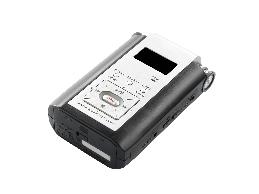On This Page
About Mental Health Conditions
Approximately one in four adults experience a mental health condition. The DSM-5, the most recent version of the Diagnostic and Statistical Manual of Mental Disorders (DSM), which is published by the American Psychiatric Association (APA), provides diagnostic criteria for mental health conditions. According to the DSM-5, a mental health condition is:
- a mental disorder is a syndrome characterized by clinically significant disturbance in an individual's cognition, emotion regulation, or behavior that reflects a dysfunction in the psychological, biological, or developmental processes underlying mental functioning. Mental disorders are usually associated with significant distress in social, occupational, or other important activities. An expectable or culturally approved response to a common stressor or loss, such as the death of a loved one, is not a mental disorder. Socially deviant behavior (e.g., political, religious, or sexual) and conflicts that are primarily between the individual and society are not mental disorders unless the deviance or conflict results from a dysfunction in the individual, as described above.
The National Alliance on Mental Illness (NAMI) (n.d.a) defines a mental health condition as:
- a medical condition that disrupt a person's thinking, feeling, mood, ability to relate to others, and daily functioning. Just as diabetes is a disorder of the pancreas, mental illnesses are medical conditions that often result in a diminished capacity for coping with the ordinary demands of life.
JAN receives numerous accommodation questions related to individuals with mental health conditions working successfully. Although there are various definitions and lists of conditions, this document covers those that are received the most by JAN. NAMI provides useful definitions of mental health conditions and statistics on their prevalence. The following (NAMI, n.d.b) is a summary of these:
- Bipolar disorder, sometimes referred to as manic depression, "is a medical illness that causes extreme shifts in mood, energy, and functioning. Bipolar disorder is a chronic and generally life-long condition with recurring episodes of mania and depression that can last from days to months that often begin in adolescence or early adulthood, and occasionally even in children."
- Borderline personality disorder (BPD) is "an often misunderstood, serious mental illness characterized by pervasive instability in moods, interpersonal relationships, self image, and behavior. It is a disorder of emotional dysregulation. This instability often disrupts family and work, long-term planning, and the individual's sense of self-identity."
- Major depression is "persistent and can significantly interfere with an individual's thoughts, behavior, mood, activity, and physical health. Among all medical illnesses, major depression is the leading cause of disability in the United States and many other developed countries."
- Obsessive compulsive disorder (OCD) "occurs when an individual experiences obsessions and compulsions for more than an hour each day, in a way that interferes with his or her life."
- Panic disorder occurs when a person "experiences recurrent panic attacks, at least one of which leads to at least a month of increased anxiety or avoidant behavior. Panic disorder may also be indicated if a person experiences fewer than four panic episodes but has recurrent or constant fears of having another panic attack."
- Post-traumatic stress disorder (PTSD) is "an anxiety disorder that can occur after someone experiences a traumatic event that caused intense fear, helplessness, or horror. While it is common to experience a brief state of anxiety or depression after such occurrences, people with PTSD continually re-experience the traumatic event; avoid individuals, thoughts, or situations associated with the event; and have symptoms of excessive emotions. People with this disorder have these symptoms for longer than one month and cannot function as well as they did before the traumatic event. PTSD symptoms usually appear within three months of the traumatic experience; however, they sometimes occur months or even years later."
- Schizophrenia "often interferes with a person's ability to think clearly; to distinguish reality from fantasy; and to manage emotions, make decisions, and relate to others."
- Seasonal affective disorder (SAD) is "characterized by recurrent episodes of depression – usually in late fall and winter – alternating with periods of normal or high mood the rest of the year." SAD is not regarded as a separate disorder by the DSM-5, but it is an added descriptor for the pattern of depressive episodes in patients with major depression or bipolar disorder.
JAN's Accommodation Solutions: Executive Functioning Deficits is a publication detailing accommodations for individuals with limitations related to executive functioning. These ideas may be helpful in determining accommodations.
Mental Health Conditions and the Americans with Disabilities Act
The ADA does not contain a definitive list of medical conditions that constitute disabilities. Instead, the ADA defines a person with a disability as someone who (1) has a physical or mental impairment that substantially limits one or more "major life activities," (2) has a record of such an impairment, or (3) is regarded as having such an impairment. For more information about how to determine whether a person has a disability under the ADA, see How to Determine Whether a Person Has a Disability under the Americans with Disabilities Act Amendments Act (ADAAA).
Accommodating Employees with Mental Health Conditions
People with mental health conditions may develop some of the limitations discussed below, but seldom develop all of them. Also, the degree of limitation will vary among individuals. Be aware that not all people with mental health conditions will need accommodations to perform their jobs and many others may only need a few accommodations. The following is only a sample of the possibilities available. Numerous other accommodation solutions may exist.
Questions to Consider:
- What limitations is the employee experiencing?
- How do these limitations affect the employee and the employee’s job performance?
- What specific job tasks are problematic as a result of these limitations?
- What accommodations are available to reduce or eliminate these problems? Are all possible resources being used to determine possible accommodations?
- Once accommodations are in place, would it be useful to meet with the employee to evaluate the effectiveness of the accommodations and to determine whether additional accommodations are needed?
- Do supervisory personnel and employees need training?
Key Accommodations:
Managing Panic Attacks: For individuals with mental health conditions, having accommodations to help manage panic attacks can be helpful.
- Flexible Schedule
- Modified Break Schedule
- Rest Area/Private Space
- Support Animal
- Support Person
- Identify and Reduce Triggers
Rest Area/Private Space: An individual may need space to rest, take medication, or perform hygiene associated with activities of daily living. An area reserved as a rest area or private space could be a reasonable accommodation. For example, during or after a seizure, people with epilepsy may exhibit behaviors such as crying, drooling, spitting, or urinating. As a result, the person may need time following a seizure to engage in activities of daily living such as grooming and changing clothes. This type of space might also be helpful to those who have sleep disorders, diabetes, or who struggle with panic attacks.
Identify and Reduce Triggers: Some disabilities or medical conditions may have specific triggers that exacerbate symptoms. If triggers are present in the workplace, it can be helpful to identify what they are and explore accommodations to help. A variety of medical conditions may have associated triggers including migraines, seizure disorders, anxiety/panic disorders, PTSD, and fibromyalgia. The process of identifying triggers is individualized. Common examples are noise, light, and stress.
Accommodation Ideas:
Situations and Solutions:
The following situations and solutions are real-life examples of accommodations that were made by JAN customers. Because accommodations are made on a case-by-case basis, these examples may not be effective for every workplace but give you an idea about the types of accommodations that are possible.
JAN Publications & Articles Regarding Mental Health Conditions
Publications
Consultants' Corner Articles
- A Support Person as an Accommodation
- Accommodating Job-Related Travel
- Accommodations Related to Commuting To and From Work
- Confidentiality of Medical Information under the ADA
- Dealing with Stress in the Workplace
- Disability Awareness Training
- Emotional Support Animals in the Workplace: A Practical Approach
- Getting to Work on Time
- How to Determine Whether a Person Has a Disability under the Americans with Disabilities Act Amendments Act (ADAAA)
Articles
- Accommodations Beyond Job Performance = Compliance and Inclusion
- Accommodations for Difficulties with Assisting Others on the Telephone Due to Stress, Anxiety, and Interpersonal Communications
- Cognitive Impairment and the Interactive Process
- Communication Difficulties in the Workplace
- Employees with Mental Health Conditions
- I Understand You Are Stressed...But Aren’t We All?
- Misophonia: Sensitivity to Sounds and Surviving the Workplace
- My Disability Made Me Do It! When It Does and Doesn’t Matter
- Panic Attacks, They Don’t Always Wait Until After Hours
- Phobias in the Workplace
- Return to Work After Hospitalization for Mental Health Treatment
- Self-Employment Options for People with Psychiatric Disabilities: A New Program That Places Lived Experiences and Peer Mentoring at Its Center
- Suicidal Ideation in the Workplace
- Supporting Employees with Mental Health and Cognitive Conditions while Teleworking
Blog Posts
- Dealing with Stress in the Workplace, Part 2
- Coronavirus (COVID-19), Stress, and Mental Health Conditions
- If We Had Known…
- Guest Blog – Website Addresses Addiction and Mental Health Conditions
- Hobby Groups, Workplace Wellness, and Stress Reduction
- Resources for Those Affected by Trauma-Related Disability and LGBTQ Workplace Supports






















